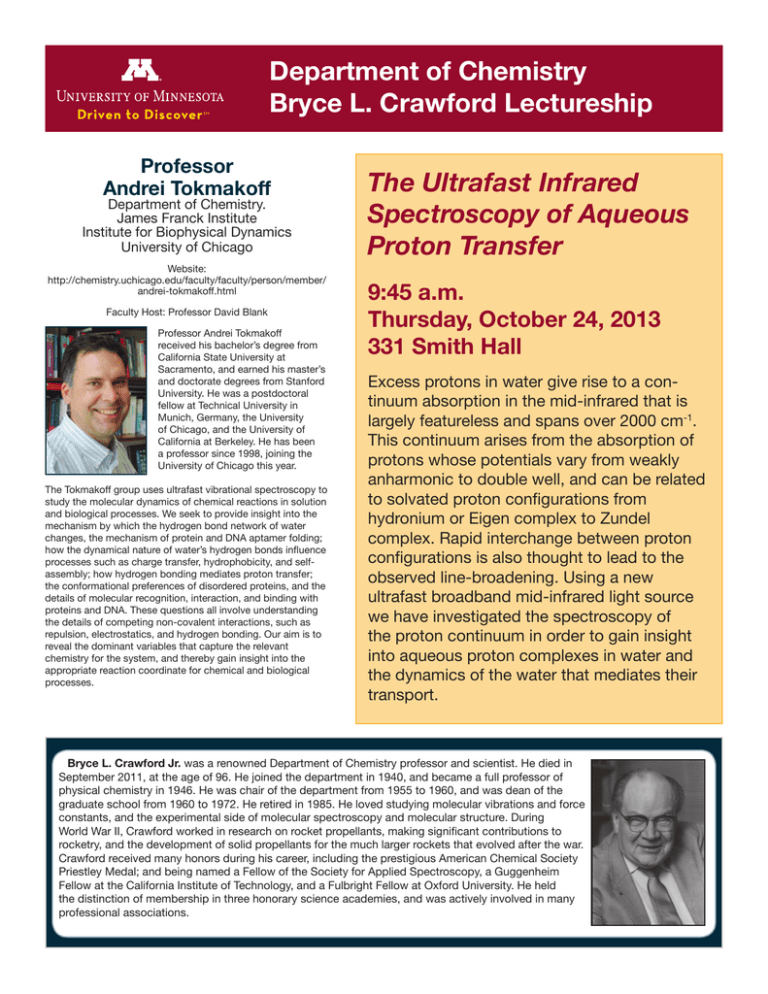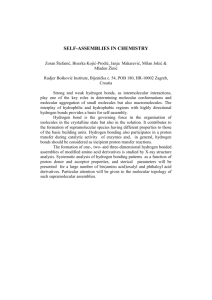Department of Chemistry Bryce L. Crawford Lectureship The Ultrafast Infrared Spectroscopy of Aqueous
advertisement

Department of Chemistry Bryce L. Crawford Lectureship Professor Andrei Tokmakoff Department of Chemistry. James Franck Institute Institute for Biophysical Dynamics University of Chicago Website: http://chemistry.uchicago.edu/faculty/faculty/person/member/ andrei-tokmakoff.html Faculty Host: Professor David Blank Professor Andrei Tokmakoff received his bachelor’s degree from California State University at Sacramento, and earned his master’s and doctorate degrees from Stanford University. He was a postdoctoral fellow at Technical University in Munich, Germany, the University of Chicago, and the University of California at Berkeley. He has been a professor since 1998, joining the University of Chicago this year. The Tokmakoff group uses ultrafast vibrational spectroscopy to study the molecular dynamics of chemical reactions in solution and biological processes. We seek to provide insight into the mechanism by which the hydrogen bond network of water changes, the mechanism of protein and DNA aptamer folding; how the dynamical nature of water’s hydrogen bonds influence processes such as charge transfer, hydrophobicity, and selfassembly; how hydrogen bonding mediates proton transfer; the conformational preferences of disordered proteins, and the details of molecular recognition, interaction, and binding with proteins and DNA. These questions all involve understanding the details of competing non-covalent interactions, such as repulsion, electrostatics, and hydrogen bonding. Our aim is to reveal the dominant variables that capture the relevant chemistry for the system, and thereby gain insight into the appropriate reaction coordinate for chemical and biological processes. The Ultrafast Infrared Spectroscopy of Aqueous Proton Transfer 9:45 a.m. Thursday, October 24, 2013 331 Smith Hall Excess protons in water give rise to a continuum absorption in the mid-infrared that is largely featureless and spans over 2000 cm-1. This continuum arises from the absorption of protons whose potentials vary from weakly anharmonic to double well, and can be related to solvated proton configurations from hydronium or Eigen complex to Zundel complex. Rapid interchange between proton configurations is also thought to lead to the observed line-broadening. Using a new ultrafast broadband mid-infrared light source we have investigated the spectroscopy of the proton continuum in order to gain insight into aqueous proton complexes in water and the dynamics of the water that mediates their transport. Bryce L. Crawford Jr. was a renowned Department of Chemistry professor and scientist. He died in September 2011, at the age of 96. He joined the department in 1940, and became a full professor of physical chemistry in 1946. He was chair of the department from 1955 to 1960, and was dean of the graduate school from 1960 to 1972. He retired in 1985. He loved studying molecular vibrations and force constants, and the experimental side of molecular spectroscopy and molecular structure. During World War II, Crawford worked in research on rocket propellants, making significant contributions to rocketry, and the development of solid propellants for the much larger rockets that evolved after the war. Crawford received many honors during his career, including the prestigious American Chemical Society Priestley Medal; and being named a Fellow of the Society for Applied Spectroscopy, a Guggenheim Fellow at the California Institute of Technology, and a Fulbright Fellow at Oxford University. He held the distinction of membership in three honorary science academies, and was actively involved in many professional associations.





